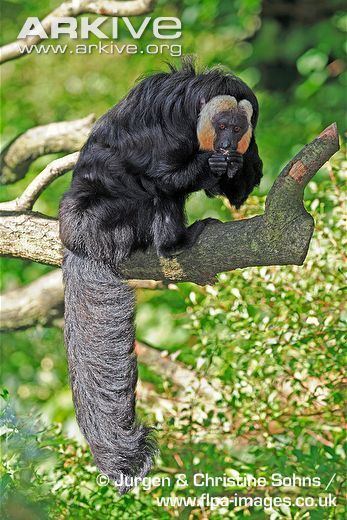Kingdom Animalia Order Primates Subfamily Pitheciinae Higher classification Pitheciinae | Phylum Chordata Family Pitheciidae Scientific name Pithecia Rank Genus | |
 | ||
Lower classifications White‑faced saki, Monk saki, Rio Tapajós saki, Equatorial saki, White‑footed saki | ||
Funny saki monkey in portland oregon zoo monkey sitting in a tree
Sakis, or saki monkeys, are any of several New World monkeys of the genus Pithecia. They are closely related to the bearded sakis of genus Chiropotes.
Contents
- Funny saki monkey in portland oregon zoo monkey sitting in a tree
- Range
- Body functionality
- Habitat and habit
- Diet
- Procreation
- Classification
- References
Range
Sakis' range includes northern and central South America, extending from the south of Colombia, over Peru, in northern Bolivia. and into the central part of Brazil.
Body functionality
Sakis are small-sized monkeys with long, bushy tails. Their furry, rough skin is black, grey or reddish-brown in color depending upon the species. The faces of some species are naked, but their head is hooded with fur. Their bodies are adapted to life in the trees, with strong hind legs allowing them to make far jumps. Sakis reach a length of 30 to 50 cm, with a tail just as long, and weigh up to 2 kg.
Habitat and habit
Sakis are diurnal animals. They live in the trees of the rain forests and only occasionally go onto the land. They mostly move on all fours, sometimes running in an upright position on the hind legs over the branches, and sometimes jumping long distances. For sleeping they roll themselves cat-like in the branches. They are generally very shy, cautious animals.
Diet
Sakis are frugivores. Their diet consists of over 90% fruit and is supplemented by a small proportion of leaves, flowers, and insects. Sakis, as well as uakaris, engage in a specialized form of frugivory in which they focus specifically on unripe fruits and seeds.
Procreation
Reproductive activities are not confined to a particular season, occurring at any point throughout the year. Females go through a gestation period lasting between 150 and 180 days before giving birth to a single offspring. Weaning of the young takes place after four months, with full maturity achieved by the age of three. These creatures have a potential lifespan of up to 30 years.
